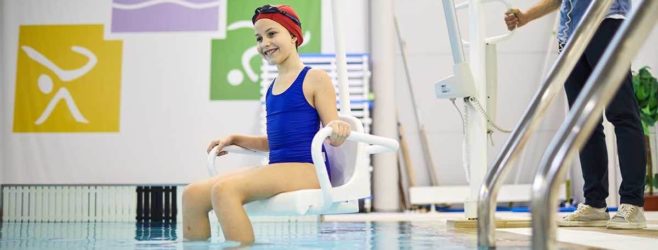Adaptive sports programs for children with disabilities can include competitive or recreational sports activities. They are just like typical sports activities, except they allow modifications that are needed for people with disabilities. Adaptive sports programs give individuals with disabilities an opportunity to embrace teamwork and connect with their community.
What Is An Adaptive Sports Program?
Adaptive sports programs are tailored toward people with disabilities. Some adaptive sports programs use a detailed classification system based on the type of disability a child has. This allows for more fair competition.
There are adaptive sports programs for children with a wide range of disabilities, including:
- Blindness or serious vision impairment
- Cerebral palsy
- Deafness or serious hearing impairment
- Difficulty with concentration, memory, or decision-making
- Severe difficulty walking
- Spinal cord injury
Adaptive sports programs are very important to children with disabilities because they help them embrace physical activity. Staying physically active is a critical component to maintaining lifelong health.
“Adults with disabilities are more likely to have obesity, heart disease, stroke, diabetes, or cancer than adults without disabilities. Physical activity can reduce the risk and help manage these chronic conditions.”
– Centers for Disease Control and Prevention (CDC)
Adaptive sports programs use modifications that make them suitable for children with all types of disabilities.
For example, track and field modifications might include:
- Allowing archers to shoot at shorter distances, at larger targets, and with the use of adaptive equipment
- Allowing athletes who use wheelchairs to throw from field chairs
- Allowing runners with visual impairments to run with a sighted guide
- Encouraging the use of carbon fiber prosthetics and braces for athletes with limb differences
- Having athletes who use wheelchairs race in specially designed racing chairs
- Using chalk (instead of a toe board) to determine the start of a long jump for visually impaired athletes
- Using lighter field equipment, such as shot-put, javelin, and discus
Benefits of Adaptive Sports
The benefits of adaptive sports for children with disabilities are immeasurable. First and foremost, adaptive sports programs keep children physically and mentally active. They also allow for socialization with other children, adults, and coaches.
“Research shows daily physical activity raises self-esteem, helps individuals develop peer relationships, increases achievement, enhances overall health, and improves quality of life.”
– The Children’s Hemiplegia and Stroke Association (CHASA)
The physical benefits of participation in sports include improved balance, agility, coordination, and flexibility. Strength and endurance are also enhanced by building muscles, bones, and connective tissues.
Physical activity improves circulation and sensation throughout the body, which can be especially helpful for children with conditions such as cerebral palsy or Erb’s palsy.
From a cognitive perspective, adaptive sports programs help to improve memory, focus, and concentration. They also teach self-control, self-discipline, persistence, and patience. More importantly, adaptive sports programs can help children with disabilities develop a positive attitude and greater self-confidence.
Some additional cognitive benefits from adaptive sports include:
- Building decision-making and strategic thinking through learning various sports plays
- Encouraging children to accept medical treatments in the hopes of improving future sports performance
- Improving connections between the brain and body
- Learning math skills and building short-term memory through scorekeeping
The social benefits of adaptive sports programs for children with disabilities include learning social skills, sportsmanship, and teamwork. Children also get more opportunities to meet others and develop friendships.
List of Adaptive Sports
There are many different sports that can be modified for children with disabilities, including:
- Archery
- Baseball
- Basketball
- Canoeing
- Cheerleading
- Curling
- Cycling (bikes and trikes)
- Dance
- Fencing
- Fishing
- Golf
- Gymnastics
- Hiking
- Horseback riding
- Karate
- Rowing
- Skating
- Skiing
- Sled hockey
- Soccer
- Swimming
- Tennis
- Track and field
- Wheelchair sports
- Yoga
National Adaptive Sports Program Organizations
National adaptive sports program organizations are designed for children and adults with all types of disabilities. To follow are a selection of such organizations.
American Association of Adapted Sports Programs
The American Association of Adapted Sports Programs (AAASP) helps national, state, and local educational agencies with the research that is required to create frameworks for adaptive sports programs.
Special Olympics
The Special Olympics is the world’s largest sports organization for people with intellectual and physical disabilities. It provides year-round training and activities to 5-million participants in 172 countries. Competitions are held every day across the globe, totaling over 100,000 events per year.
Move United
Move United was formed in 2020 as a merger of Disabled Sports and Adaptive Sports USA. It is devoted to promoting sports for youths and adults with physical disabilities. Move United operates programs in over 150 local chapters across the United States.
BlazeSports
BlazeSports works with children and veterans with physical disabilities, such as spina bifida, spinal cord injury, traumatic brain injury, cerebral palsy, amputations, and more. Its programs help disabled people become more independent and achieve success in school and at work.
Local Adaptive Sports Programs
In addition to national adaptive sports organizations, there are also many state-sponsored and local programs, which are often provided through schools.
Some tips on finding local adaptive sports programs include looking into:
- Community sports clubs
- Local parks and recreation programs
- Local middle schools or high schools
Additionally, you may wish to ask other parents who are involved in youth sports to connect you with the coaches. Coaches of local teams and schools may be able to point you in the right direction. They may even be available to hire for one-on-one instruction.
Paralympic Games
Introducing children with disabilities to the Paralympic Games is a great way to encourage them to chase their dreams and pursue their passion for sports. The Paralympic Games focus on inclusivity and not allowing disabilities to discourage athletic pursuits.
To follow are highlights of the interesting history:
- The first competition for wheelchair athletes, called The Stoke Mandeville Games, took place in 1948. It involved 16 injured servicemen and women, who took part in archery.
- The Stoke Mandeville Games then became the Paralympic Games, first taking place in Rome, Italy in 1960. The competition featured 400 athletes from 23 countries.
- In 1976, the first Winter Games were held in Sweden and, as with the Summer Games, they now take place every four years.
Since 1992, the Summer and Winter Paralympic Games have occurred in the same cities and venues as the Olympics. Each of these competitions includes a Paralympics Opening Ceremony and Paralympics Closing Ceremony.
Find an Adaptive Sports Program Near You
There are many adaptive sports competitions and tournaments that allow children to travel and experience new things. Adaptive sports programs can be found throughout the country with a bit of research.
The best way to begin is to decide how much physical activity is right for your child based on their fitness level. You may pick an activity that your child enjoys and find ways for them to participate.
It is also important to talk with your child’s health care professional first to understand how your child’s disability may affect their ability to safely take part in adaptive sports programs.



